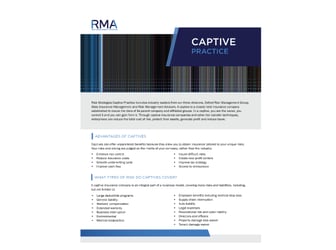
Risk management plays a vital role in ensuring the success and stability of businesses. It involves identifying, assessing, and mitigating potential risks that could negatively impact an organization. Businesses can make informed decisions and effectively navigate uncertain situations by implementing a structured risk management process. In our world, we focus on alternative risk and the utility of captive insurance.
Coordination and focus of the risk managers, loss control and captive insurance consultants can reap significant upside.
- Identifying and Assessing Risks: Risk management involves identifying and assessing potential risks that a company may face. These risks could be related to property damage, liability, business interruption, employee health and safety, and more. By understanding these risks, a company can develop strategies to mitigate or minimize their impact.
- Risk Financing Strategies: Once risks are identified, companies must decide how to finance potential losses. Traditional methods include retaining the risk (self-insuring), transferring the risk to an insurance company through purchasing commercial insurance, or creating a captive insurance company.
- Captive Insurance as a Risk Financing Tool: A captive insurance company is a form of self-insurance that allows a company to create its own insurance entity to cover its risks. The captive insurance company insures the risks of the parent company and potentially its affiliates. This approach gives the parent company greater control over its insurance program, tailoring it to its specific needs.
- Customized Coverage: Captive insurance enables companies to customize insurance coverage to match their unique risks and risk tolerance. This can be particularly valuable for risks that are difficult to cover in the commercial insurance market or where the costs of traditional insurance are prohibitively high.
- Integration with Risk Management: Captive insurance is a powerful tool within a comprehensive risk management strategy. By owning and operating a captive insurance company, a company can formalize its risk management efforts and develop a structured approach to handling risks. This might involve implementing safety measures, loss prevention programs, and risk mitigation strategies.
- Cost Management: Captive insurance can potentially lead to cost savings over time. When a company pays premiums to a commercial insurer, a portion goes toward the insurer's administrative costs and profits. With a captive insurance company, these costs might be reduced, and underwriting profits could be retained within the company if the captive insurance company is structured properly.
- Alignment of Interests: Captive insurance companies foster a closer alignment of interests between the parent company and the insurer. The captive insurance company's success depends on effectively managing risks, which encourages the parent company to invest in risk reduction efforts and safety measures.
- Tax Benefits: Captive insurance arrangements can offer tax advantages, such as deductions for insurance premiums paid to the captive insurance company and potential tax deferral on investment income generated by the captive insurance company's reserves. However, these benefits must be navigated carefully to ensure compliance with tax regulations.
- Regulatory Considerations: Captive insurance involves adherence to insurance regulations, both at the captive insurance company's domicile (location) and potentially in other jurisdictions where the parent operates. Regulatory compliance is crucial to maintaining the legitimacy of the captive insurance company and its transactions.
In essence, risk management and captive insurance complement each other by allowing companies to take control of their risks and tailor insurance solutions to their specific needs. By integrating these two strategies, companies can achieve a holistic approach to risk mitigation, financial protection, and potentially enhanced financial outcomes. When considering and implementing a captive insurance solution, it's advisable for companies to work with experienced professionals in risk management, insurance, and taxation.
Explore
- Solutions
- Captive Insurance
- Captive Insurance Overview
- What is Captive Insurance?
- Definition of Captive Insurance
- Types of Captive Insurance
- Typical Structures of a Captive Insurance Program
- Why Form a Captive Insurance Company?
- Captive Insurance Utilization and Value
- Evaluating a Captive Insurance Program
- How to Setup a Captive Insurance Company
- Operating a Captive Insurance Company
- Captive Insurance Operating Costs
- Retaining Risk vs. Financing Risk
- Risk Distribution Through Captive Insurance
- Taxation of a Captive Insurance Company
- Captive Insurance Domiciles
- News and Insights
- About Us
Practice Leader(s)

Captive Practice Leader, Managing Director

Captive Practice Leader, Managing Director
Max Jong is the Captive Practice Leader and Managing Director at Risk Management Advisors, an alternative risk and captive management firm. Max began his career at Northwestern Mutual in 1994 after graduating from UCLA. Over 12 years, he built a successful financial services practice while heading up an office overseeing 50 professionals in Los Angeles and Irvine, California. The office was perennially one of the top producing organizations in the Northwestern Mutual system.
Max joined his partners at Risk Management Advisors in 2007 as he began to work with more sophisticated mid-market business owners. RMA specializes in the design, formation, and management of captive insurance companies. There’s also an emphasis on self-funded group benefits as well as other creative alternative risk management strategies. The firm assists business owners in better managing their risks without jeopardizing their balance sheets. In 2019, he headed up a merger with Risk Strategies, a Top 10 private national specialty insurance brokerage and consulting firm. Since then, he was appointed as the Captive Practice Leader to oversee the growth and development of the organization.
For five years, Max served as an Independent Director for Fiat Lux Risk and Insurance Company, one of the largest and most sophisticated captive insurance companies. Fiat Lux was established by the University of California Regents to better manage the broad risks of the University of California system.
Max has also been a lifelong supporter of Big Brothers Big Sisters of Greater Los Angeles. He initially volunteered to be a mentor in 1995 and is currently mentoring his second "Little." Max was asked to join the Board of Directors in 2000 and eventually served as their Board Chair. After 20+ years as an active board member, he continues to support the organization by serving as a Trustee.
He is married to Alice, and they’re raising two young children, Hunter and Hayden. Max and Alice are happily married despite her irreparable mistake of going to USC. He loves to travel, golf, and is a hopeful Lakers fan.
Resources







